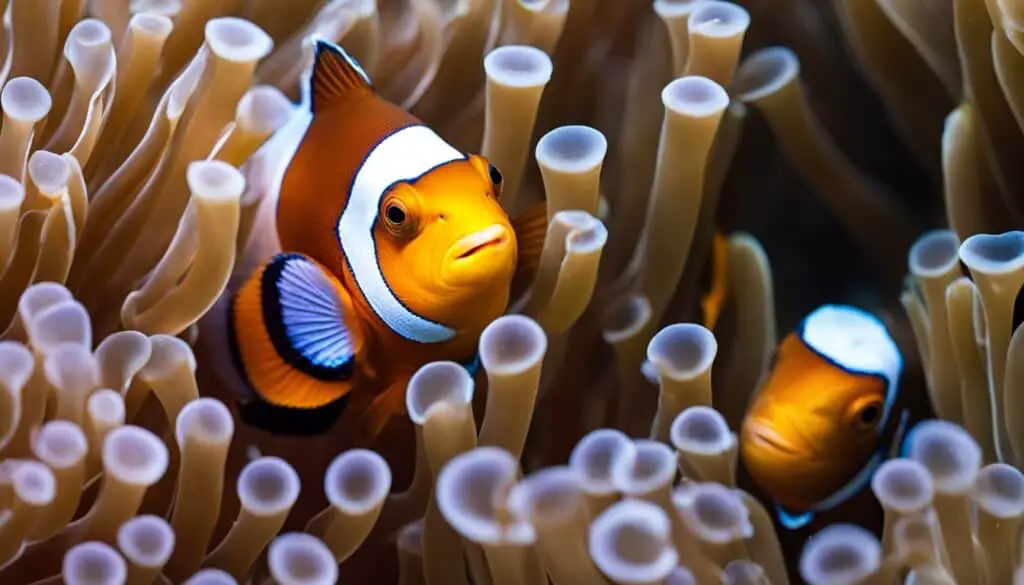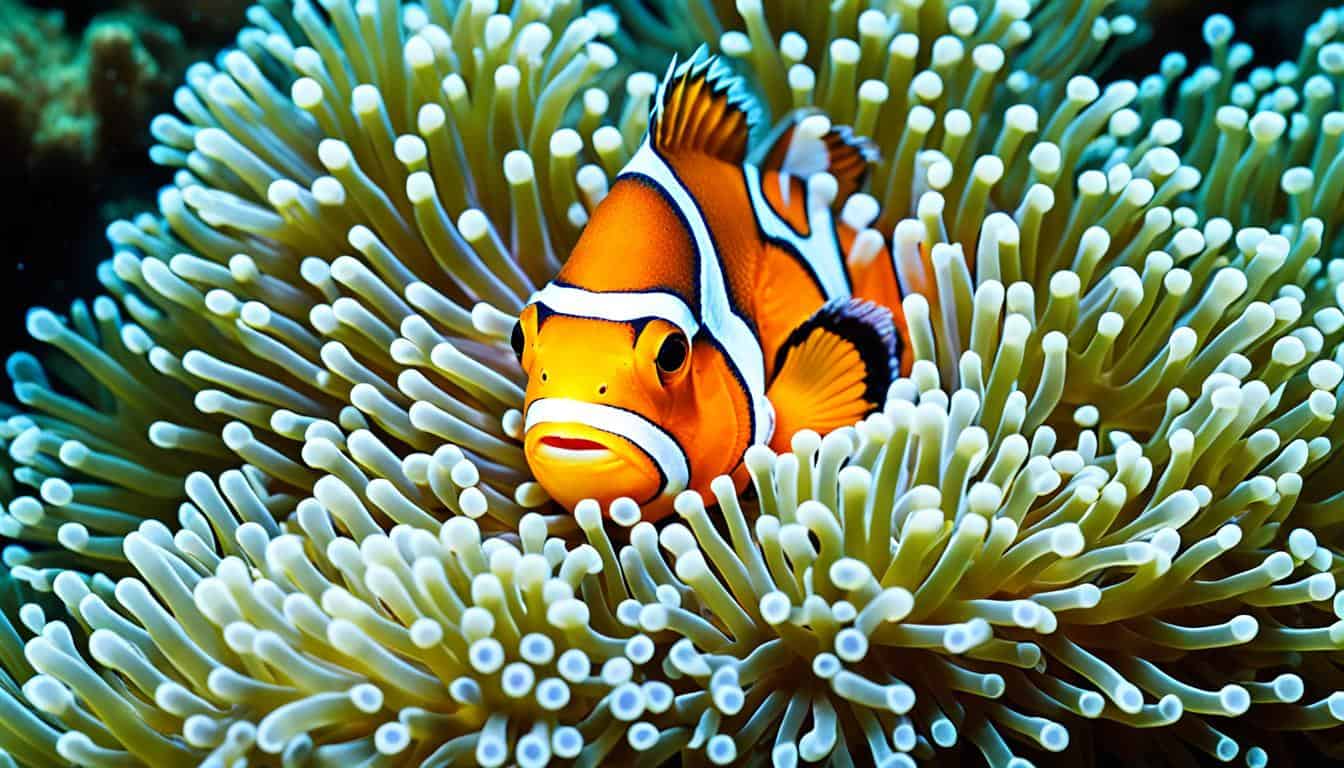Clownfish have amazing ways to protect themselves in the ocean. They live among the sea anemone’s deadly tentacles, thanks to their special defense methods. These fish use thick mucus, smart behaviors, and live with sea anemones to stay safe from predators. Their defense strategies are a great example of nature’s cleverness, showing how these colorful fish survive in tough conditions.
Understanding Clownfish Defense Strategies
Clownfish have many ways to stay safe in the ocean’s dangers. They live with sea anemones, which protect them from predators. This relationship is a great example of how different creatures work together in the sea.
Clownfish also have special moves and traits to help them. They can move fast to avoid danger. You’ll see them zip in and out of the anemone’s tentacles. This not only confuses predators but also uses the anemone’s stinging cells against them.
Learning about clownfish defense can teach us a lot. Their partnership with anemones and their quick moves show how complex marine life can be. These strategies help clownfish survive in tough conditions.
| Defense Strategy | Description | Benefits |
|---|---|---|
| Symbiotic Relationship | Clownfish live within the tentacles of sea anemones. | Provides protection and shelter from predators. |
| Agility | Quick movement to evade threats. | Increases chances of survival during predator encounters. |
| Behavioral Traits | Utilization of anemone stings for defense. | Deters predators from attacking. |
How do clownfish defend themselves?
Clownfish use many ways to protect themselves from predators in the ocean. They have a thick mucus layer on their bodies. This layer keeps them safe from the sea anemone’s stinging tentacles, which they live among.
This mucus is thicker than most fish have, letting clownfish live close to their anemone homes safely.
Clownfish also have special ways to defend themselves. They do a dance to get used to the anemone’s tentacles. This dance helps them live safely with the anemones.
This dance shows they belong and helps them avoid danger. It’s key for their survival in a tough environment. By using both body and behavior, clownfish stay safe and live well with their anemone friends.
Symbiotic Relationships with Sea Anemones
The bond between clownfish and sea anemones is a perfect example of nature’s teamwork. These relationships help both species do well in their home, showing how marine life is interconnected. Clownfish live safely under the anemone’s protection, and in return, they help the anemones in many ways.
Mutual Protection from Predators
Clownfish and sea anemones work together to keep each other safe from predators. The anemone’s tentacles act like a shield, keeping away threats. Clownfish find a safe place to live, lowering their chances of being eaten. This partnership lets clownfish live in a place that would be risky otherwise.
Providing Nutrients and Cleaning Services
Clownfish also help their anemone friends by exchanging nutrients and cleaning them. The waste from clownfish feeds the anemones, helping them grow strong. Clownfish also clean the anemone by eating algae and debris. This teamwork makes their home environment better for both species.
Clownfish Self-Defense Mechanisms
Learning about clownfish self-defense mechanisms shows how these creatures survive in the ocean. They use a thick mucus layer and special behaviors to protect themselves and their territory. These strategies help them avoid predators and stay safe.
Thick Mucus Layer for Protection
The clownfish protection methods include a thick mucus layer. This layer shields them from the sea anemone’s stinging cells. It also makes them taste like the anemone, keeping predators away.
This special relationship lets clownfish live safely with their anemone friends. They can stay close without getting hurt.
Behavioral Adaptations to Avoid Threats
Clownfish also use behaviors to stay safe. When they feel threatened, they hide in their anemone. This keeps them out of harm’s way.
They might also act aggressively towards others to protect their territory. These actions help keep predators away and show how well they defend themselves.

Clownfish Survival Tactics in the Wild
In their natural home, clownfish use smart ways to stay safe from threats. They live close to sea anemones, which protect them and give them a good place to live. This special relationship helps them avoid predators.
Clownfish are very protective of their homes and what they own. When strangers come near, they fight to keep their space safe. They show how tough they are by facing dangers that are bigger than them. Their bright colors also warn others and help them survive.
They move very fast too. Clownfish can quickly go in and out of anemones. This helps them get away from danger and stay safe in the anemone’s tentacles. These skills help them stay safe in the ocean.
| Survival Tactic | Description |
|---|---|
| Symbiotic Relationship | Uses sea anemones for shelter and protection from predators. |
| Aggressive Territorial Defense | Shows aggressive behavior to protect their territory. |
| Quick Movements | Moves fast among anemone tentacles to avoid threats. |
| Coloration | Bright colors warn potential predators. |
Learning about these survival tactics shows how adaptable clownfish are in the ocean. They not only do well in certain places but also show the delicate balance of life under the sea.
Camouflage Techniques of Clownfish
Clownfish have amazing ways to hide that help them avoid predators. They blend in with the bright colors and patterns of their anemone homes. This makes them hard to see in the water. It shows how they’ve adapted to live in a dangerous place.
Blending with Anemone Colors and Patterns
Clownfish look just like their anemones. This helps them hide well, as it makes them hard to see. It’s a key way they stay safe in the wild.
Resting Among Stinging Tentacles
Clownfish also hide among the anemone’s stinging tentacles. These tentacles would hurt most fish, but not clownfish. They have a special mucus that keeps them safe. This way, they get a safe place to stay and also keep predators away.
FAQ
How do clownfish defend themselves?
Clownfish mainly rely on living with sea anemones for safety. They have a special mucus layer that protects them from the anemones’ stinging tentacles. They also have behaviors to avoid predators and defend against threats.
What are the main clownfish protection methods?
Clownfish use a thick mucus layer as a shield against anemone stings. They also have a special dance to safely get used to the anemone’s tentacles. This helps them avoid getting hurt.
How do clownfish utilize their symbiotic relationships?
Clownfish and sea anemones have a helpful relationship. The anemones give them a safe place and protect them from predators. In return, clownfish help by eating algae and cleaning the anemones. This helps both species survive in their home.
What are clownfish self-defense mechanisms?
Clownfish have many ways to defend themselves, like their thick mucus layer for protection from anemone stings. They also move quickly to avoid danger and fight off intruders to protect their territory.
What survival tactics do clownfish use in the wild?
Clownfish use their relationship with anemones and quick movements to stay safe. They are very protective of their homes and resources. This is key to surviving in a tough marine world.
How do clownfish camouflage themselves?
Clownfish blend in with their anemones by matching their colors and patterns. This helps them hide from predators. Living among the anemones’ stinging tentacles also protects them from threats.







